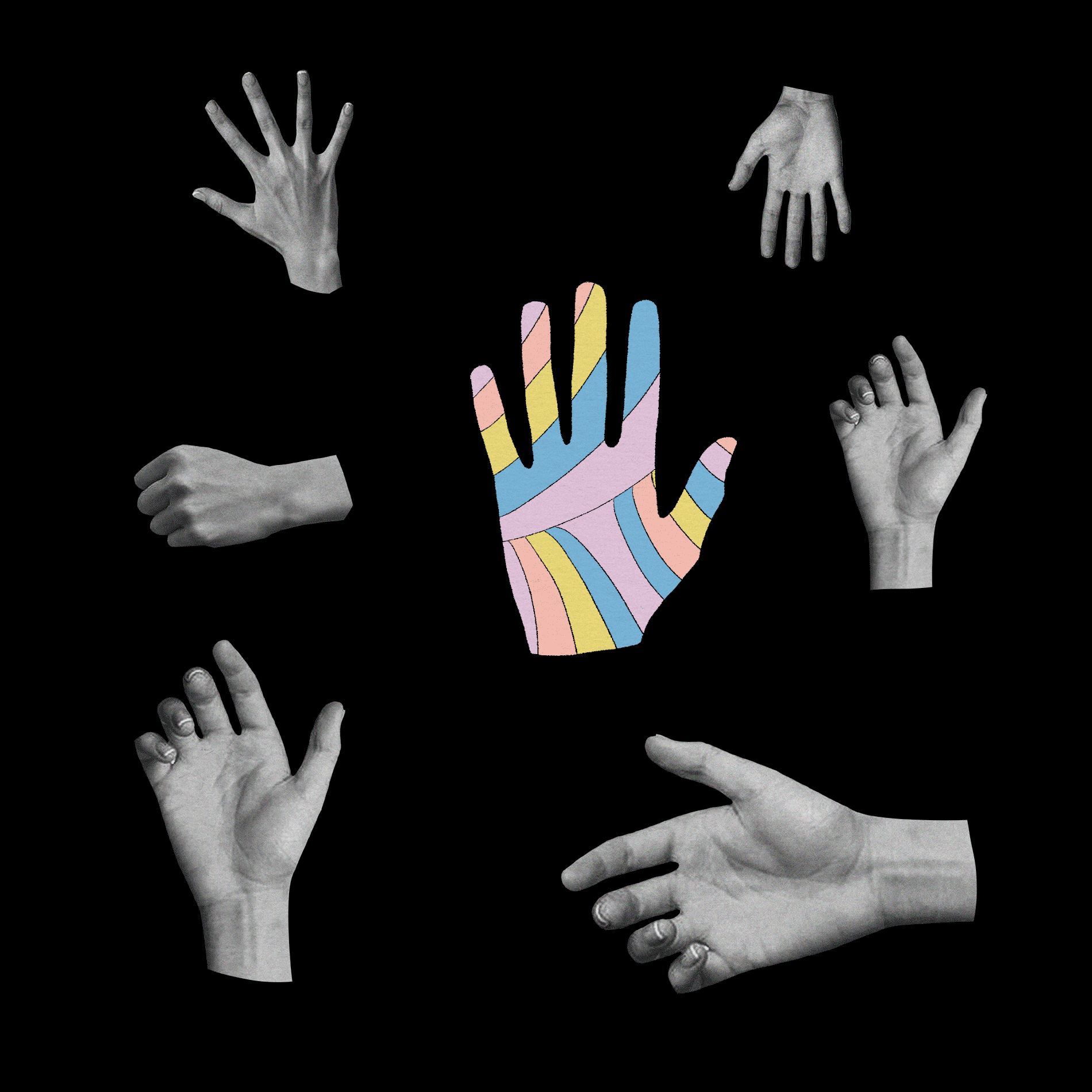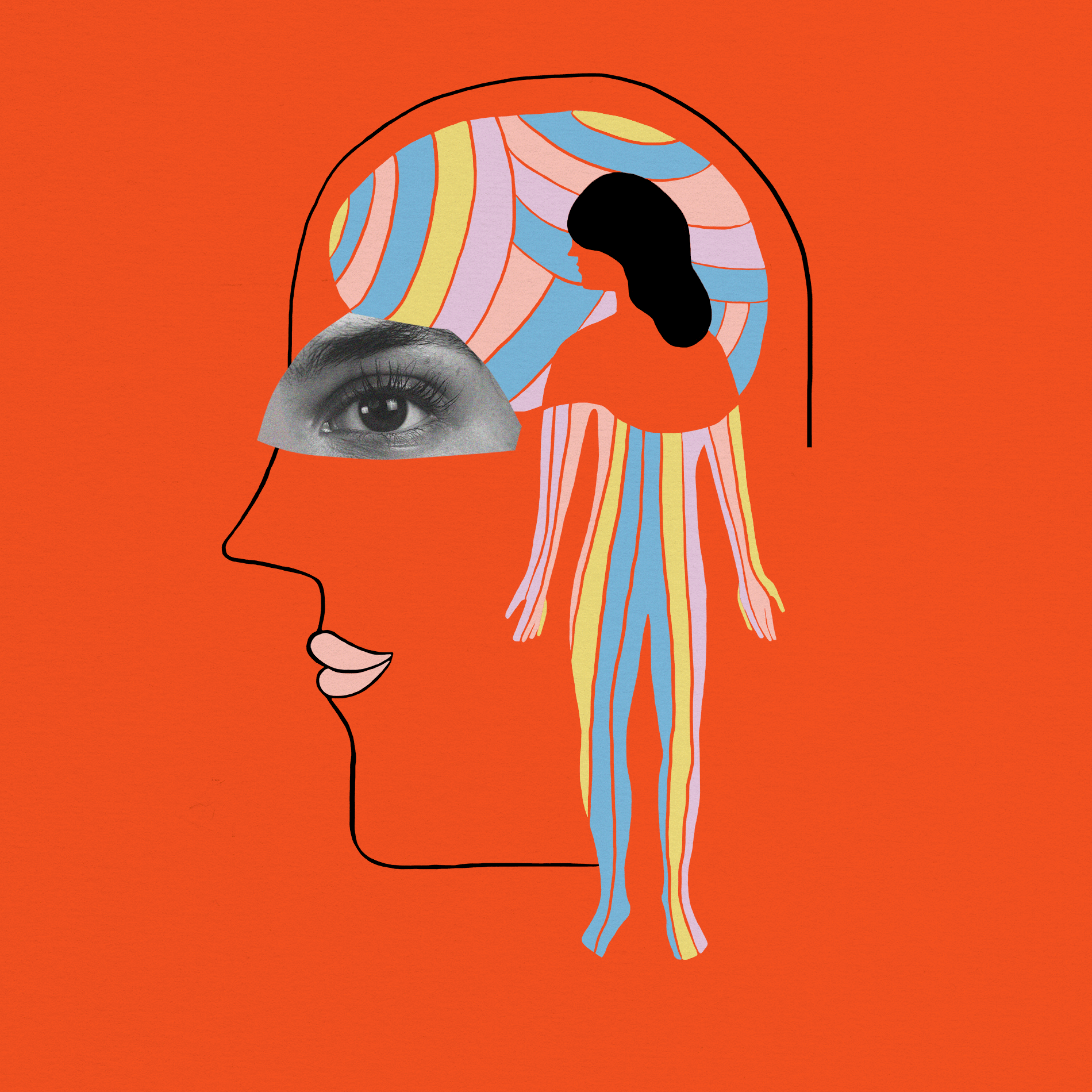
Rethinking repetitive behaviors in autism
Autistic people have long maintained that repetitive behaviors are beneficial. Emerging evidence in support of this idea is shaping new therapies.
As Raya Shields goes about her day, she sometimes rocks back and forth, flutters her hands and presses down on her eyelids with her fingers to create a kaleidoscope of visual patterns.
Shields has ‘stimmed’ like this for as long as she can remember. She can be seen fidgeting with a piece of fabric in some of her baby photos. In other pictures, she is folding herself into a human pretzel of arms and legs. Now 28, Shields cannot imagine going even an hour without stimming. In loud, busy environments, such as on the subway train she takes to get to work, she calms herself by rocking or folding herself up. And when she visits a favorite place, such as her neighborhood laundromat, she jumps up and down with excitement, flapping her hands.
“[Stimming] helps me feel grounded when I’m anxious or overwhelmed, but it’s also a way that I express my joy, fascination or excitement,” she says. Shields is autistic, and she also has Tourette syndrome and obsessive-compulsive disorder.
Others haven’t always looked kindly on her stims, or repetitive behaviors. Her teachers told her to suppress her stims, calling them inappropriate and disruptive — and so she tried to stifle them. To stop herself from snapping her fingers in high school, she sometimes crossed her fingers so tightly that they hurt. But that made it almost impossible to write, and her schoolwork suffered.
As an adult, Shields started to encounter autistic people who saw stimming as a positive part of their identity. Over time, she grew to embrace her own stims. Last year, in fact, Shields helped launch the first International Day of the Stim to provide an outlet for autistic people to celebrate their stims. Throughout the day, they shared their stimming experiences on social media or in coffee shops all across Canada. The event had a grassroots feel, says Anne Borden, co-founder of Autistics for Autistics (A4A), a self-advocacy organization that helped coordinate the event. “It was really an example of autistic people reclaiming something that, through negative and abusive therapies, had been taken away,” she says.
For many people like Borden and Shields, a shift in the perception of repetitive behaviors is long overdue. Restricted and repetitive behaviors are a central feature of autism and include not only repetitive movements such as hand-flapping, but also an intense interest in particular topics — such as train schedules or maps — and difficulty altering routines. Most scientists historically viewed them as something to eliminate or at least minimize — especially if it appeared to hinder a child’s daily life.
But studies suggest that some of the behaviors, such as body-rocking and arm-waving, help guide typical development. And many non-autistic children also engage in stims such as fidgeting or fiddling with objects. What’s more, a growing body of evidence from the past decade reinforces the notion that repetitive behaviors can help autistic people relieve sensory overload, cope with anxiety and express emotion.
As such, scientists have begun to realize that taking the behaviors away might do autistic people more harm than good. “There’s been a changing in thought about repetitive behaviors,” says Benjamin Yerys, assistant professor of psychology in psychiatry at the University of Pennsylvania.
Research on the roots of repetitive behaviors is also beginning to suggest that people may stim just for pleasure: Some repetitive behaviors activate the brain’s reward circuitry. “There’s been a lot of autistic researchers that have really been quite vocal about this, and I think we are listening to that as a field,” says Clare Harrop, assistant professor of allied health sciences at the University of North Carolina at Chapel Hill. As experts increasingly accept the positive sides of stimming, they are tailoring treatment plans for autism to consider the purposes these behaviors so often serve.

Typical ties:
The idea of eliminating repetitive behaviors sprang from some of the first accounts of autism. In the 1940s, Leo Kanner and Hans Asperger both described the behaviors as a way for autistic people to shut out the external world. This negative view gained momentum from later studies that suggested the behaviors can compromise socialization, interfere with learning and impair cognitive abilities. As a result, some autism therapies, including the widely used applied behavior analysis, initially focused on eradicating repetitive behaviors, even by way of physical restraint, slapping or electric shocks.
The therapy no longer uses such extreme deterrents; therapists now encourage children to adopt alternative behaviors in place of challenging ones — clasping hands together, for example, to curb hand-flapping. But many autistic people still protest against this approach. Any attempt to alter stimming, Shields says, is a form of violence against autistic people because it denies them control over their own bodies. “Everyone should be really worried about any kind of therapy that has that as a goal or an aim,” she says.
There is ample evidence, in fact, that some stims are not all that unusual. Repetitive movements, such as arm-waving and rhythmic kicking, serve important functions during typical development. Early repetitive movements help infants explore how their bodies move as they transition to goal-directed motions such as reaching and crawling. In autistic children, the latter behaviors may not fully overtake the repetitive ones, says Jason Wolff, associate professor of educational psychology at the University of Minnesota in Minneapolis. “That developmental process that we see in all children just might be interrupted in some way in kids with autism,” he says.
A different developmental trajectory in autism may reflect altered sensory processing: If sensory feedback from the environment is not properly integrated with motor signals, autistic infants may not be able to refine their early repetitive movements into more complex, goal-directed ones.
As they get older, autistic and typical children both continue to engage in repetitive behaviors, such as fiddling with objects as they play, according to a 2014 study. Children with autism just display more of these behaviors, as well as a greater variety, compared with typical children. It may also be harder to redirect autistic children from the behaviors, says Harrop, who led the analysis.
The developmental patterns of repetitive behaviors may also vary by type. Wolff and his colleagues tracked repetitive behaviors in 202 younger siblings of autistic children, who have high odds of being diagnosed with the condition, and 53 typical children. Among the baby sibs who were later diagnosed with autism, repetitive motor behaviors — such as hand-flapping and rocking — increased steadily throughout toddlerhood, whereas they decreased in everyone else. But other repetitive quirks, such as wanting to keep to routines, increased in all of the children, although the increase was most pronounced in the autistic children. The team is continuing to track repetitive behaviors in all of the children as they reach school age.
It will be important for researchers to compare repetitive behaviors in autistic people with those in children who have other conditions, such as attention deficit hyperactivity disorder, obsessive-compulsive disorder and schizophrenia, Wolff says: “A really interesting place for our field to go is to understand the similarities and differences in these patterns of behaviors across all types of conditions, including typical development.”
”“Stimming helps me feel grounded when I’m anxious or overwhelmed, but it’s also a way that I express my joy.” Raya Shields
Finding meaning:
Repetitive behaviors serve important functions not only during development. They appear to help autistic people in a number of ways.
Many people with autism stim as a way to calm themselves and cope with overwhelming thoughts or sensations. Some stims may serve as a mode of communication, says autistic researcher Steven Kapp, who gathered the perspectives of 31 autistic adults earlier this year. Skin-picking, for example, speaks to stress; open and outward hand flaps can signal positive emotions, whereas flaps closer to the body can reflect negative feelings. Stims, in other words, are an outlet for “uncontainable emotion,” says Kapp, lecturer in psychology at the University of Portsmouth in the United Kingdom. “Obviously we don’t need a treatment for happiness.”
Kapp’s findings echo what many autistic people have said for years. Results from other studies, too, are increasingly aligning with these ideas. Brain-imaging work, for example, is confirming that some repetitive behaviors are pleasurable. When autistic adults look at pictures of things people on the spectrum are often interested in, such as vehicles and technology, they show increased activation in a brain region associated with reward. This same region, the ventromedial prefrontal cortex, responds less to monetary rewards in autistic participants than in controls, hinting at a difference in what autistic people find rewarding.
There are also differences between autistic and typical children in the caudate nucleus, another brain region involved in generating a sense of reward, according to new work from Yerys and his colleagues. Compared with typical children, those with autism show less activation in this structure in response to video clips of social gestures or facial expressions of approval, and more in response to personalized video clips of their special interests. The higher the activation in response to a special interest, the greater the child’s social impairment.
The findings expand upon the social motivation hypothesis, or the idea that autistic people find social interaction less rewarding than special interests. This change in priorities could be at the root of some repetitive behaviors, Yerys says. “I am a personal believer that the more research we would do on it, I think we would find that there is a lot of positive valence and emotion associated with repetitive behaviors.”
Repetitive movements may also help autistic people adjust the degree of stimulation they experience. That idea has been around for decades, says Matthew Goodwin, associate professor of health sciences and computer science at Northeastern University in Boston, Massachusetts. But researchers have been able to test it only in the past several years, thanks to new wearable technology that can track heart rate and other physiological signals in minute detail.
In March, Goodwin and his team asked 10 autistic children and young adults to don vests embedded with heart-rate sensors. Video cameras recorded the participants’ body-rocking and hand-flapping throughout the day. Both behaviors, the researchers found, tracked with a distinctive cardiovascular pattern recorded by the sensors: About four seconds before the participants rocked or flapped, their heart rates tended to quicken. The heart rates peaked once the movements started, and then slowed back down again.
The spike in heart rate before the stims is surprising, Goodwin says — as is the fact that this pattern holds across different types of movements and different people. By way of an explanation, he says that hand-flapping and body-rocking might help autistic individuals manage input from their environment, and some people may even do it intentionally. “Our results would suggest that you can’t rule this function out,” he says. Goodwin’s lab has also found subtle variations in how people perform repetitive behaviors, hinting at the idea that different people use these behaviors in distinct ways.
Goodwin says his findings highlight the dangers of assuming repetitive motor behaviors are purposeless. “Maybe [autistic people] are doing it for a reason, and we should figure out that reason before we decide to take it away from their repertoire.”
”“Maybe autistic people are doing it for a reason, and we should figure out that reason.” Matthew Goodwin
Drawing the line:
With the growing awareness that repetitive behaviors can have benefits, clinicians are beginning to take a new approach to autism treatments. Instead of stamping these behaviors out or redirecting them, they are trying to learn what drives the behaviors in each person and whether some are better left alone. “We’ve come to understand that individualization and honoring the individual matters, so that we’re a little more careful about what we target and the rationale for doing so,” Wolff says.
Many experts now aim to intervene only when necessary. For example, Yerys says he would not want to eliminate behaviors that soothe overstimulation or spark happiness. But “at the same time,” he says, “I want to balance that as a clinician with seeing whether any behavior gets in the way of having a higher quality of life.”
Finding that balance is not always easy. Caregivers sometimes ask clinicians to focus on treating these behaviors if they find them extremely stressful — for instance when a child repeatedly bangs his head against a wall or bites, or if the behaviors restrict family life. “On both sides there needs to be education and discussion so we can come to a common understanding of what are the positives and the benefits [of repetitive behavior] and then also where it can get in the way,” Yerys says. Clinicians also feel compelled to intervene when repetitive behaviors amount to self-harm, he says.
Scientists are still figuring out exactly when and how to intervene in these instances. Shields says she redirects her own biting stims with ‘chewlery,’ specially designed pendants and bracelets that she can bite when she feels agitated, instead of her own arm. But there are no drugs or behavioral interventions that effectively stem all repetitive behaviors. “In general, we don’t know enough about why these behaviors are occurring, which makes treatment more difficult,” says Brian Boyd, associate professor of applied behavioral science at the University of Kansas in Lawrence.

Some experts say the best approach is to treat the factors that may underlie repetitive behaviors, such as a general discomfort with change. Boyd’s team, for example, has developed a method that guides parents to encourage play and flexible behaviors over repetitive ones in their autistic children. The approach showed promise for decreasing a range of repetitive behaviors in one small study of preschoolers. Another therapy, dubbed ‘Unstuck and On Target,’ aims to ease rigidity in autistic children, teaching them the value of being flexible and solving problems.
Keeping a check on sensory overload, simply by wearing sunglasses or a brimmed hat, for example, can also alleviate the need to stim in some cases. And the same holds true for designated, stim-friendly spaces in classrooms and other potentially overstimulating environments, such as airports and stadiums.
Finding the best ways to intervene — and learning when not to — can only be achieved with greater input from the autistic community, including from those who are minimally verbal, Shields says. When she sometimes tries to curb her stims in public to avoid harassment or staring, she finds it exhausting. “It’s important [for researchers] to recognize that it’s the way autistic people move through our world and engage with it,” she says. “It’s part of the way we learn and process information, and it’s a way we express our feelings and communicate.”
Recommended reading

Developmental delay patterns differ with diagnosis; and more

Split gene therapy delivers promise in mice modeling Dravet syndrome

Changes in autism scores across childhood differ between girls and boys
Explore more from The Transmitter

‘Natural Neuroscience: Toward a Systems Neuroscience of Natural Behaviors,’ an excerpt

